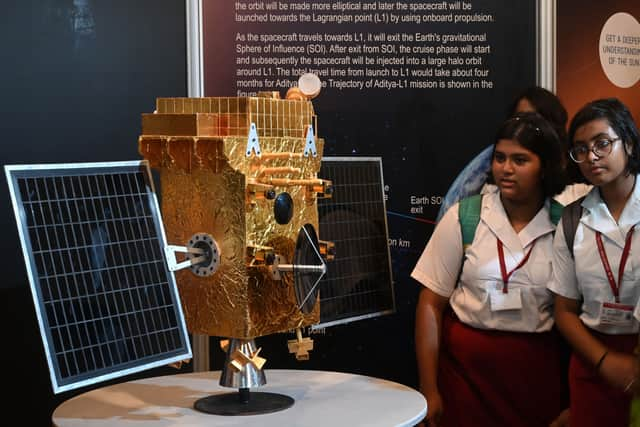Aditya-L1: India successfully launches first Sun satellite a week after moon landing
and live on Freeview channel 276
India has successfully launched Aditya-L1, its first observation mission to the Sun, just a week after becoming the first nation to land near the Moon's south pole.
Aditya-L1 lifted off at Sriharikota on Saturday at 11:50 India time (06:20 GMT) and now will travel 1.5 million km (932,000 miles) from the Earth - 1% of the Earth-Sun distance.
Advertisement
Hide AdAdvertisement
Hide AdThe mission is carrying scientific instruments to observe the sun’s outermost layers in a four-month journey.


The mission is carrying scientific instruments to observe the sun’s outermost layers in a four-month journey.
Aditya-L1 will now travel several times around the Earth before being launched towards L1 and from this vantage position, it will be able to watch the Sun constantly - even when it is hidden during an eclipse - and carry out scientific studies.
The probe's name comes from Surya - the Hindu god of Sun who is also known as Aditya.
Advertisement
Hide AdAdvertisement
Hide AdL1 stands for Lagrange point 1 - the exact place between Sun and Earth where the Indian spacecraft is heading.
According to the European Space Agency (ESA), a Lagrange point is a spot where the gravitational forces of two large objects - such as the Sun and the Earth - cancel each other out, allowing a spacecraft to "hover".
Once Aditya-L1 reaches its spot, it would be able to orbit the Sun at the same rate as the Earth - meaning it will need little fuel to operate.
An hour and four minutes after launching on Saturday morning, Isro declared it "mission successful".
Advertisement
Hide AdAdvertisement
Hide Ad"Now it will continue on its journey - it's a very long journey of 135 days, let's wish it [the] best of luck," Isro chief Sreedhara Panicker Somanath said.
Project director Nigar Shaji said once Aditya-L1 reaches its destination, it will benefit not only India, but the global scientific community.
Isro says the orbiter carries seven scientific instruments that will observe and study the solar corona (the outermost layer); the photosphere (the Sun's surface or the part we see from the Earth) and the chromosphere (a thin layer of plasma that lies between the photosphere and the corona).
The studies will help scientists understand solar activity, such as solar wind and solar flares, and their effect on Earth and near-space weather in real time.
Advertisement
Hide AdAdvertisement
Hide AdThis move comes just a week after the nation successfully launched a craft to the lunar south pole to investigate the water which could have benefits for future spaceflight. It also plans a joint mission with Japan to send another probe to the moon by 2025 and an orbital mission to Venus within the next two years.
Comment Guidelines
National World encourages reader discussion on our stories. User feedback, insights and back-and-forth exchanges add a rich layer of context to reporting. Please review our Community Guidelines before commenting.
